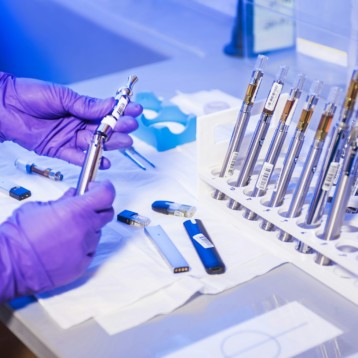|
Photodynamic therapy (PDT) is a relatively new form of skin cancer treatment. PDT combines a light-sensitive drug (called a photosensitizer or photosensitizing agent), and the projection of a specific type of light onto the photosensitizer in order to kill the cancer cells. At first, a photosensitizer in the form of a cream is rubbed onto the area affected by cancer and is absorbed by the tumor cells. The tumor is then exposed to light emitted from a laser or from another light source. When the photosensitizer absorbs this light, it produces an active form of oxygen that destroys nearby cancer cells. It appears that by damaging the blood vessels in the tumor and by activating the immune system to attack the tumor’s cells, PDT prevents the necessary nutrients from reaching the tumor, causing it to shrink or even destroying it completely,.
PDT may be preferable to conventional skin cancer treatments, such as surgical excision and radiotherapy, which are unsuitable for large or multiple lesions and can lead to poor cosmetic outcomes. PDT has been shown to eradicate certain superficial skin lesions with remarkable selectivity, giving a more satisfactory clinical outcome.
PhD student Desmond Morrow and his colleagues at Queen’s University’s School of Pharmacy recently demonstrated that their novel jet injection device can significantly increase the amount of photosensitizer delivered into skin, compared to the amount delivered when using the conventional PDT approach of applying a bioadhesive patch to the skin. The jet injection system is based on a needle-free injector, which produces a high velocity liquid jet with sufficient intensity to penetrate the skin. This new method of administering the drug can increase the amount of photosensitizer that reaches the cancerous cells. Therefore, jet injection has the potential to increase the efficiency of PDT in skin cancer treatment.
Morrow‘s breakthrough could benefit the growing numbers of skin cancer patients being treated with PDT. The new finding is of major importance in cases of ‘difficult to treat’ skin tumors for which success of the conventional PDT approach is limited because of the poor penetration of the active agent into the tumor.
TFOT recently covered a couple of other researches dealing with techniques for selective and targeted killing of cancer cells. The techniques include usage of Alpha-particles, developed at the University of Washington, and a method for killing cancer cells using electrical fields developed at the Technion Institute in Israel.
More information on Queen’s jet injection research can be found on the Queen’s University Belfast website.
Further discussion of the new Queen’s University jet injection can be found on the TFOT forums.











